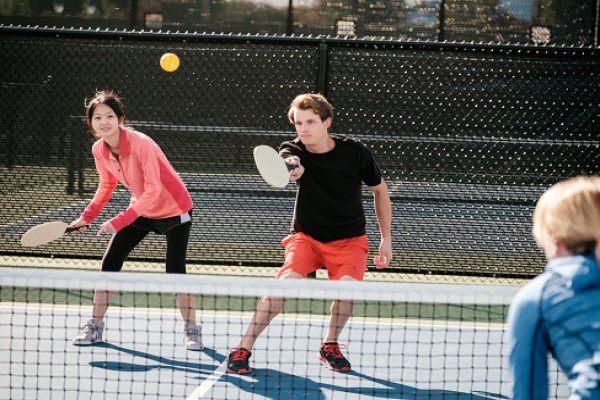If you’re like me, you’re always on the lookout for fun, engaging ways to stay active. That’s where open play pickleball comes in. It’s a game that’s been gaining popularity across the US, and it’s easy to see why.
Open play pickleball is a blend of tennis, badminton, and ping-pong. It’s a game that’s easy to pick up, but hard to master. With the right strategy and a bit of practice, you’ll find yourself hooked in no time.
Whether you’re a seasoned athlete or just looking for a new hobby, open play pickleball offers a unique opportunity to get moving and have fun. So, let’s dive in and explore what this game is all about.
What is open play pickleball?
Let’s delve deeper into understanding what open play pickleball truly is. Essentially, it’s a mash-up of a few sports that you may already be familiar with: tennis, badminton, and ping-pong. It’s played on a court roughly the size of a badminton court with a lower net and a perforated plastic ball, similar to a whiffle ball, and paddles that are slightly larger than ping-pong paddles.
Open play simply refers to a style of organizing play that allows participants to join in on games as they please, without a set schedule or required commitment. It’s social, it’s flexible, and it’s a key part of what makes pickleball so appealing.
What I found especially captivating when I first started participating is that anyone, regardless of their fitness level or sports prowess, can pick up a paddle and start to enjoy the game almost immediately. Yes, there are nuances and strategies to learn if you want to excel, but the basics can be grasped quickly. Let’s just say: it doesn’t take long before you’re swept up in the fast-paced fun and camaraderie of the sport.
Moreover, it’s not just a game for seasoned athletes. It’s a sport that caters to all groups: young or old, athletic or not. There are countless examples of people picking up the sport later in life and falling in love with it. So whether you’re looking for a new way to stay active, a social outlet, or a new hobby, open play pickleball might just be the thing for you.
The rules of open play pickleball
Just as in any sport, open play pickleball comes with its unique set of rules. While they’re easy to master, it’s pivotal for players to understand them to fully enjoy the game. Let’s look into these rules to understand the dynamics of the game better.
Serve Rules: The serving player commences the game. They must keep one foot behind the baseline, serve underhand, and hit the ball into the diagonal opposite serve box. If the ball doesn’t land within the box or make it over the net, it’s deemed a fault.
Scoring Rules: The points in open play pickleball are scored by the serving team only. When the team wins a rally, they score a point. However, an important aspect of pickleball scoring to remember is the numbers 1-1-2 rule, which refers to the unique sequence of serving turns in doubles.
Faults: Faults are instances where players lose a rally. Examples of faults include not getting the serve over the net, hitting the ball out of bounds, volleying the ball (hitting it before it bounces) within the no-volley zone, or missing a return shot.
No-volley Zone Rules: The no-volley zone, or ‘kitchen’, is a seven-foot zone on both sides of the net. Players can’t perform volleys within this zone. It’s acceptable to step into the kitchen to play a ball that’s bounced within it, but volleying in the kitchen is a fault.
Remember, open play pickleball is all about having fun and being inclusive. While it’s vital to understand these rules, it’s not about rigidly adhering to them. The spirit of open play encourages flexibility and participation from all. I reckon the best way to learn is to dive in and give it a go.
Equipment needed for open play pickleball
Let’s talk about the equipment you’ll need for open play pickleball. A basic game of pickleball requires just a few key pieces, each designed to complement the game’s fun-filled nature.
First on our list is the pickleball paddle. Unlike the equipment used in tennis or badminton, pickleball paddles are solid, usually crafted from lightweight materials like wood, graphite, or polymer. A typical pickleball paddle is larger than a ping pong paddle but smaller than a tennis racquet.
Another key piece of pickleball equipment is the ball itself. Pickleball balls are akin to wiffle balls, they’re light, perforated plastic balls designed to travel at moderate speeds. Today’s market offers outdoor and indoor variants, and while they may seem similar, they do vary primarily by the size and number of holes.
And let’s not forget: you’ll need a designated playing court. Pickleball courts are smaller than tennis courts, measuring around 44 feet in length and 20 feet in width. If an official court isn’t available, you can create a makeshift one on a flat surface.
Play pickleball in comfortable athletic wear. Footwear should provide good support and traction, because the game demands quick lateral movements.
Before I forget, one highly recommended but often overlooked tool is a pickleball net. The net height and structure add unique challenges to the play, this isn’t just any net. The official net height is 34 inches at the center, going slightly to 36 inches at the sidelines.
Here are some details of the essential items:
| Equipment | Description |
|---|---|
| Pickleball Paddle | Solid, lightweight, larger than a ping pong paddle but smaller than a tennis racquet |
| Pickleball Balls | Light, perforated plastic balls, varies by indoor or outdoor use |
| Court | 44 feet in length and 20 feet in width |
| Athletic Wear | Comfortable clothing with good support footwear |
| Pickleball Net | 34 inches high at the center and 36 inches high at the sidelines |
Each piece of gear plays a significant role in shaping the game of pickleball. But remember, open play means flexibility. Be resourceful, make do with what you have, and let the fun commence.
Tips for beginners in open play pickleball
Getting into open play pickleball can seem daunting at first. But fear not! With just a few helpful tips, it’s possible to jump in with relative ease.
First and foremost, understand the fundamentals of pickleball. This includes grasping the flow of the game and learning the scoring system. Mastering the basics includes knowing where you should be standing on the court and when you should be moving. Practice scoring to make sure it’s second nature.
Always challenge yourself to improve your serves. A well-placed serve can set the tone for entire games and provide a solid advantage early on.
Making sure you have the right equipment is also essential. As previously discussed, the paddle, ball, court size, and even your athletic wear can impact your game.
Next, invest your energy in observing more experienced players. Their style, tactics and strategies can provide invaluable insights. Watch where they place themselves on the court, the spin they put on the ball, their level of aggression or defense during gameplay. Apply these insights to your own game where possible.
A key aspect to keep in mind is sportsmanship and etiquette. Be respectful to both the game and players. Open play pickleball fosters a sense of community and consideration goes a long way.
Finally, practice cannot be overemphasized. Get on the court as often as you can. Whether it’s for a casual game or a little bit of practice, the more you play, the better you’ll get.
To summarize the key points, here’s a quick rundown:
- Grasp the basics: Understand the flow of the game and the scoring system.
- Give importance to your serve: Practice your serves and coin strategies that can get you ahead in the game.
- Must-have equipment: Ensure you have the correct paddle, ball and athletic wear.
- Learn from experienced players: Observe strategies, tactics, and gameplays from the pros.
- Abide by sportsmanship and etiquette: Respect for the game and the players is crucial.
- Practice: Get on the court as often as you can.
Getting started in open play pickleball might seem a little challenging, but with these starter tips, you’ll be on your way to becoming a seasoned player in no time. All it takes is a bit of effort, practice, and a whole lot of love for the game.
Benefits of playing open play pickleball
Embracing the game of open play pickleball brings a host of benefits. It’s more than just a thrilling match; it’s a multifaceted experience that offers physical, mental, and social perks.
For starters, pickleball is an excellent workout. It engages the whole body, from your legs powering you across the court to your arms and core dictating the paddle’s trajectory. It enhances physical fitness, stamina, and agility but also helps in coordination. In a single game, you’ll find yourself racing, stopping, pivoting, and lunging, movements that often don’t get exercised in our everyday routine.
Mentally, pickleball sharpens your reflexes and strategy skills. Playing pickleball is like a tactical warfare, every shot, every position holds immense strategic value. From figuring out your opponent’s pattern, exploiting their weaknesses to choosing the right moment to strike, you’ll be exercising your mind in ways that most physical activities don’t demand.
Now let’s not forget the social aspect of open play pickleball. It’s a game that fosters a community spirit. Unlike singles games like tennis or badminton, pickleball usually involves four players. This allows for more interaction, team spirit, and cooperative gameplay. It’s a great way to forge new friendships or strengthen existing ones. Also, there’s heaps of support from spectators, players, and sports enthusiasts alike. They’re eager to share advice and cheer each other on, cultivating a welcoming and fun-filled atmosphere.
Practicing good sportsmanship and respect for competitors, rule adherence, these lessons learned during a heated match often apply off the court as well. They provide life lessons that’ll serve you well in all walks of life.
Playing pickleball can be challenging and rewarding, yet it’s also playful and exhilarating. The game can become a part of your lifestyle, bringing a sense of satisfaction and an avenue for continuous learning and improvement.
Conclusion
So, there you have it! Open play pickleball isn’t just a game, it’s a lifestyle that can bring immense benefits to your life. With the right gear and a team spirit, you’re set for an exciting and healthy journey. It’s not just about physical fitness, but mental agility and social connections too. Remember, every piece of equipment counts, but flexibility and resourcefulness are key. Open play pickleball is a rewarding challenge that keeps you on your toes, literally and figuratively. So why wait? Grab a paddle, find a court, and let’s get the ball bouncing! It’s time to experience the thrill and satisfaction of open play pickleball for yourself.














0 Comments